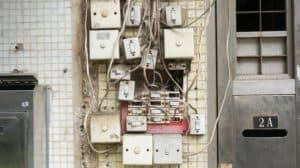
Do you have cloth covered wiring and wonder about your electrical safety? Do you suspect having cloth-covered wiring in your home? We answer all questions below.
What is it, and where did it come from?
It’s important to note that just because you live in an older home doesn’t mean that you certainly have cloth covered wiring and are in danger. Your home could have been rewired by a previous occupant or have another older wiring system that could be functional and safe.
The first thing to do to be sure is to call an electrician for an inspection.
Cloth-covered wiring describes wires covered in cloth material or fabric. This wiring system was the norm from the first half of the 20th century and served its purpose during those times.
Homes built before 1960 tend to have cloth covered wiring. However, despite its extensive use and efficiency, cloth wiring is now considered a fire hazard, outdated, and unsafe for modern homes.
What changed?
Modern homes are very different from vintage or older homes, and so are the demands on electrical power. Nowadays, cloth wiring possesses the following shortcomings;
- Brittleness that leads to wear and tear.
Cloth insulation becomes brittle over a long time, and this leads to wear and tear on the material. As the cloth begins to flake away the wires are exposed and this increases the possibility of a fire.
- The use of asbestos.
Asbestos is a cheap material with insulating power that was commonly used in the past. Some cloth-covered wiring incorporated asbestos for better insulation, but asbestos is also a dangerous carcinogen. As the cloth deteriorates this harmful substance can become airborne and go on to harm human health.
- Attack from rodents and insects.
Unlike rubber components, cloth wiring attracts attacks from rodent and insects. These creatures chew on the cloth, damaging it and exposing the wires within. This, of course, creates a fire hazard in the home.
- Lacks sufficient insulation quality.
Under modern home demands, cloth-covered wiring lacks sufficient insulation. The power demand is much more than when cloth wiring was designed and this leads to a buildup of heat in the wires and ultimately, a fire hazard.
These reasons make cloth-covered wiring dangerous to your home. Aside from the safety concerns, having cloth-covered wiring can affect your home insurance. Most insurance companies equally consider cloth-covered wiring a fire hazard, and even with a letter from your electrician saying your system is safe, they are hardly keen to grant coverage.
To determine if your cloth-covered wiring is a fire hazard and a threat to the safety of your home and family, hire a professional electrician for an inspection.

